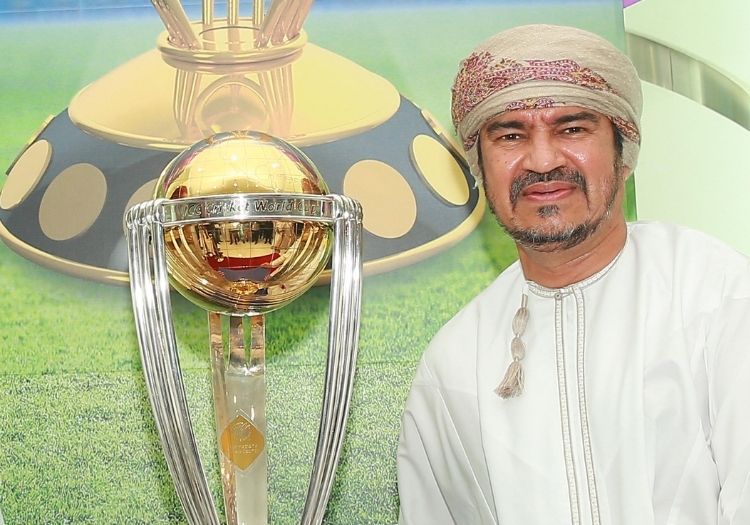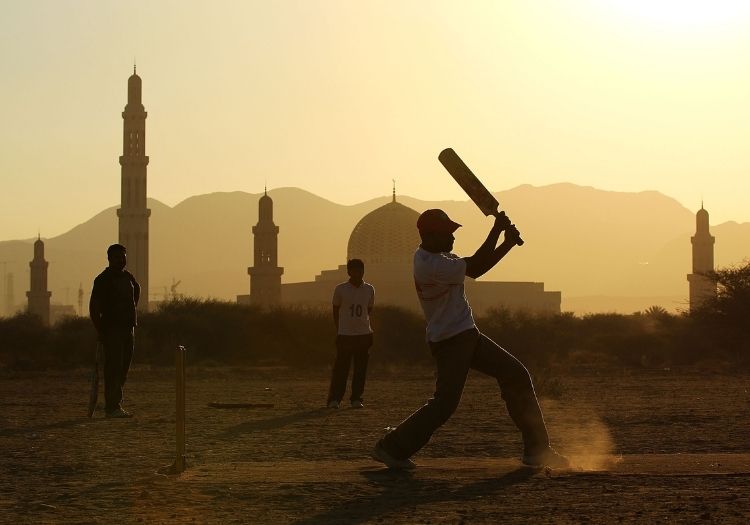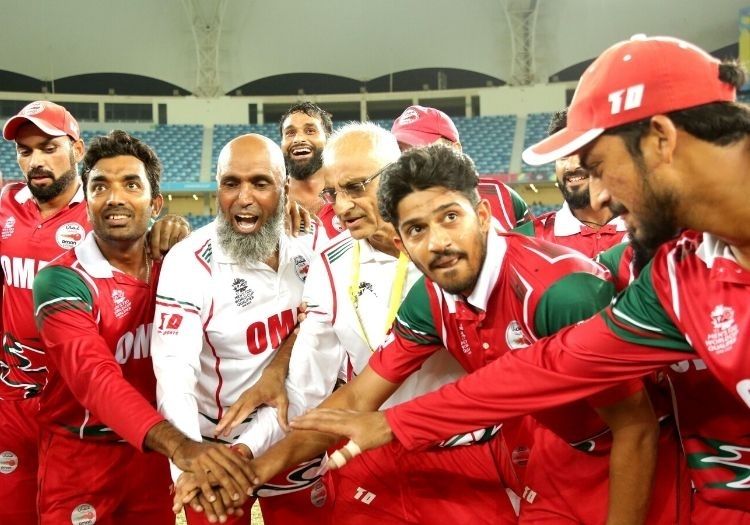JAMES COYNE: Oman have risen from having no grass cricket grounds 10 years ago to co-hosting the T20 World Cup – though they still have much to do by October 17

Two thirds of the way through our WhatsApp call the reception drops out, and Pankaj Khimji calls me back through the old-fashioned means of a normal mobile phone call.
“Sorry about that,” he chuckles. “I had to drive over a 1,000-foot mountain pass.”
For anyone expecting another featureless desert landscape and empty stands when pictures from Oman flash onto TV screens during the early matches of the T20 World Cup, they may be pleasantly diverted by the backdrop of the Al Hajar Mountains behind the Al Amerat Cricket Ground. This kind of thing matters in cricket, especially during a pandemic, when the only audiences will be remote.
Besides, there are no stands at all at what Khimji, the chairman of Oman Cricket, calls “the best village cricket ground you’ve ever seen”.
“It’s not your typical desertscape,” Khimji reassures The Cricketer. “It’s a beautiful landscape behind, with a vista of the mountains. We’re in a basin with mountains all around us. I just hope the TV cameras will do justice to it all.
“It’s most important of all that Oman is shown in a good light, not just Oman Cricket.”
That sentiment betrays the unavoidable reality behind the meteoric rise of Omani cricket over the last decade.
***
The Sultanate of Oman is an absolute monarchy nestled between the UAE, Saudi Arabia and Yemen, with the sultan as head of state. No major project would have been possible without the direct intervention of the government: it was the Ministry of Sports which donated the land where the impressive Al Amerat complex now stands.
The sultan, Haithim bin Tariq, is a cricket fan, and was present with Khimji in the royal box for the 2019 World Cup final at Lord’s.
It just so happened that his predecessor as sultan, his cousin Qaboos bin Said, died in January 2020, just as Oman was hosting a Cricket World Cup League 2 qualifying event; the last matches had to be cancelled as the Sultanate went into mourning at the end of Qaboos's 50-year rule, during which the country had underdone staggering levels of development.
As for Khimji, he is director of Khimji Ramdas, a sixth-generation family business which has operated as a major wholesalers in Muscat since 1870.

Oman are due to host part of the upcoming T20 World Cup
His late father, Kanak, who died in February, was known as the world’s only Hindu sheikh, after being conferred with the title by the sultan. He was awarded with a Lifetime Service award by the ICC in 2011.
The progress that father and son have been able to help bring about in cricket has been stark in its own right.
In the 1950s and ’60s there were a handful of cricket matches a year in Oman, then a de facto British colony usually described as “medieval” in the Western press. Such matches on gravel fields and matting wickets were perhaps dependent on the personal enthusiasm of members of the Anglophile royal family, the Indian trading community, Royal Navy visits or the Brits out there assisting the regime – somewhat shadily in the case of the 13-year Dhofar Rebellion (the full UK government papers on the matter are being released only this year).
Since Qaboos deposed his wayward father in 1970, the country has grown up fast, and immigrants from the Indian subcontinent have flocked to the Sultanate for work; one of the unintended consequences has been a cricketing explosion.
Such was the expat player pool that in 2005 Oman managed to reach a World Cup Qualifier for the first time – despite the country not possessing one grass pitch or ground.
The Azhar Ali story
To install one was always going to require significant investment and upkeep: in 2007, a study by the Associate cricket aficionado (and soil expert) Roy Morgan ranked Muscat the driest cricketing centre in the world.
When MCC toured in 2010, the likes of Keith Dutch and Will Gidman played on an artificial wicket inside a running track on the multi-sport Royal Oman Police Ground.
“I remember it well,” says Khimji. “It was one of MCC’s very first pink-ball games, funnily enough. The ground was less an oval and more a loop.”
It took four years and 2 million Oman rials (US$5.2m), but Khimji led the project to construct two handsome turf grounds and an indoor school at the Al Amerat complex 25km out of downtown Muscat by 2013.
Suddenly, Associate tournaments – which for years had tended to gravitate to the likes of the UAE and Malaysia – began to be awarded to Oman. Their infrastructure has raised Oman from a scruffy cricketing outpost to the stage where Khimji can now declare “we’ve now become the No.4 venue in the region, after Dubai, Abu Dhabi and Sharjah”.
***
When it became clear the T20 World Cup might have to be moved from India to the UAE due to fears of a third wave of Covid-19, Khimji wrote to the BCCI asking them to consider Al Amerat as a possible extra venue nearby. When the inevitable venue change was made, his plea was answered.
Cynics will complain about the allocation of fixtures, which have yet to be finalised, and will surely give Oman some kind of home advantage.
It seems certain that Muscat’s involvement will be restricted to the preliminary stage, involving the eight teams – Sri Lanka, Bangladesh, the Netherlands, Papua New Guinea, Ireland, Namibia, Scotland and Oman themselves – who did not qualify automatically to the Super 12s through the T20I rankings. Oman, like other Associate sides, have been sat around twiddling their thumbs since the pandemic started.
One of Oman’s functions in all this appears to be to allow the three stadiums and squares in the UAE time to recover from the stresses of cramming in 31 IPL games in 27 days before the T20 World Cup really gets going.

Oman qualified for the T20 World Cup by beating Hong Kong in a playoff (copyright: ICC Business Corporation FZ LLC 2018)
“Realistically we’re looking at the preliminary rounds,” acknowledges Khimji. “We’re expecting the ICC and BCCI officials to arrive this weekend, and they will inspect the venues, and go through the details and once we’ve all sat down we’ll know if we have six games, or eight, or 12, or whatever it is.”
It may be jarring for global audiences to watch World Cup matches at a ground without grandstands, but Khimji says the venue will want for nothing come October 17.
In March, Muscat came very close to hosting its first Test matches, between Afghanistan and Zimbabwe. In the end they decided to play two Tests in the more familiar surroundings of Abu Dhabi.
Khimji says: “We secured Test accreditation at short notice, and we would have been a Test-hosting country. But we never expected the World Cup. Sometimes the stars and constellations are aligned for you.”
They may need to be, as Khimji will know how important a World Cup is to the Associate game. Aside from the UAE, not many Associate Members get the opportunity to host World Cup matches. And yet it is the revenues generated from ICC major tournament broadcasting rights that provides the funds for the ICC to divvy out to the scores of Associates.
Graeme van Buuren: Lost in limbo
There is still a dizzying amount of work to do over the next 15 weeks to ensure Al Amerat conforms to global televised standards.
“We’re purely cricket-focused,” Khimji says. “We don’t have grandstands or corporate boxes. But we’re as beautiful and as kitted out as the best village ground you’ve ever seen.
“There’s a bio-bubble we’ll somehow have to conform with. And if we have two back-to-back games on the same ground with a half an hour or hour changeover, we’ll have to have another set of dressing rooms built – which is fine – as we have to sanitise them and the teams from the first game won’t have vacated yet.
“We’ll have to install an LED screen for all the DRS technology which players and audiences are accustomed to now. We’ll have to put up some TV towers.
“And lights… we didn’t realise we’d be hosting a World Cup in 2021. So our floodlights are not currently up to World Cup standard. We’ll have to install new technology meeting the four HD requirements.
“The deadline is complicated by the fact we are also hosting a World Cup League 2 qualifying event in September. So we’ll have to make sure everyone is vacated by September 15 to install everything. We’re currently heading the table in that competition and want to maintain that advantage in trying to qualify for the 2023 World Cup.
“But we’ll meet the deadline.”

Oman in action against Kenya at their Al Amerat ground outside Muscat (copyright: ICC Business Corporation FZ LLC 2018)
The actual task of bringing up to eight teams, ICC staffers and media into Oman during a pandemic does not faze Khimji.
He has spoken before of how the Sultanate approved visas for 30 Afghans or Zimbabweans within 72 or 36 hours – quite something when Oman has not been issuing visas for citizens of those nations for years. When he has asked the state for a shipment of buses to transport players around, they arrived promptly.
“We don’t have to battle red tape,” says Khimji. “We had the pre-Olympic sailing qualifiers here in the midst of the pandemic and that went off just fine.
“By the end of August Oman is on track for two-thirds of the population to have had the first jab, and one third to have had their second shot. By September that will go up to 50 per cent.
“By the time all the teams arrive hopefully we’ll be in a similar position as Wembley was for England v Germany!”
***
As for the national team, such exposure is relatively new for them too: Oman did not play a televised match until the qualifier for the 2016 T20 World Cup, where four wins secured their spot in India. In their first match, they pulled off the shock of the preliminary round by beating Ireland.
It was clearly an expat operation, with just one player, the fast bowler Sufyan Mehmood, actually born in Oman, though with plenty of usefully unorthodox and unshackled players like the powerful Zeeshan Maqsood and slingy Munis Ansari.
But there is encouragement from the fact that 35 schools in the country now take part in floodlit T20 competitions.
Khimji is steadfast when it comes to maintaining the amateur ethos in Oman Cricket. In the manner of Pakistan cricket, most of Oman’s 60 senior domestic teams are sponsored by corporate houses, and not a single player – even the international players – is on a national contract.
Almost all cricketers in the country are in full-time day jobs and provided with only a modest stipend by the board, to cover daily meals; just a handful of the leading players are sponsored sufficiently by companies to be able to skip work.
At a time when world cricket celebrates the issuing of central contracts to Brazil’s female players, Oman’s structure may seem antediluvian. But Khimji says it is their way of retaining a cricket system free of corruption and self-interest.
“We have an amateur structure and make no mistake: we will maintain that. The players are amateur, the board are amateur – we do not have any financial privileges. If you are involved in Oman Cricket you do it for the right reasons. And we always come out as the underdogs that way.”

Oman's national side taking on Uganda at Al Amerat (copyright: ICC Business Corporation FZ LLC 2018)
He told the Emerging Cricket podcast earlier this year: “We pride ourselves on being a professionally amateur cricketing nation, where the commercial lure of being a national cricketer hasn’t quite bitten yet. So long as we stay amateur, I think we’ll stay sane.
“We debate this all the time. I think our mandate is to maintain our current level – to stay within the top 17 in ODIs and the top 20 in T20Is. After that, I think we’ll know where we’re going and what’s lacking. I see a very strong USA and Nepal coming up, and one or two surprises out of Africa, and will we be able to stand the onslaught and the professionalism that may come in?”
Khimji has more influence than ever, having been nominated as vice-president of the Asian Cricket Council. He also stood late last year as an Associate representative for the ICC Chief Executives’ Committee, but lost out by one vote.
His ACC role has given him the ear of Jay Shah, probably the most powerful man in cricket by dint of his roles as BCCI secretary and ACC president, not to mention being the son of India’s home affairs minister.
Khimji knows the greats of India’s 1983 World Cup squad from the early days of one-day exhibition matches in Sharjah, when he and his father (both educated in India) would make the long drive from Muscat and even be allowed to enter the dressing rooms. It certainly does no harm to know the likes of Sunil Gavaskar and Ravi Shastri today.
Khimji says: “When I talk to Jay Shah we talk as colleagues now. So we can talk about revitalising the ACC and I don’t need to break the ice anymore. I converse with him regularly about ACC business and clearly we will be over the T20 World Cup too.”
***
In keeping Oman’s players and officials grounded, Khimji says he is indebted to his long-time development manager and national coach, Duleep Mendis, who was one of Sri Lanka’s first outstanding Test batsmen and famously got stuck into Ian Botham and co on their Test debut at Lord’s in 1984. He has relocated to Oman for the job.
“He is my henchman,” jokes Khimji. “What would I do without the man? I have no words to express how grateful I am.
“He’s old school. He promotes a very clean, unadulterated atmosphere. Cricket’s all about that – for me it’s a gentlemanly and gentlewomanly sport.
“The moment you have too many issues pulling or pushing things in a certain direction you lose that enjoyability. Hopefully I won’t suddenly become arrogant through hosting a World Cup.”